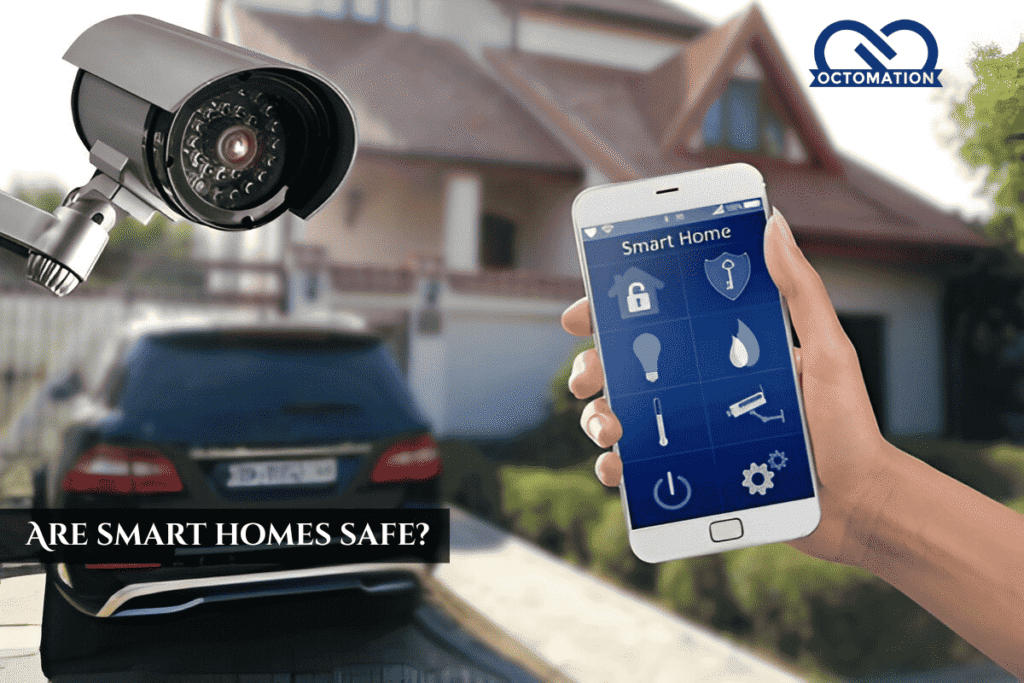Are smart homes safe?

The emergence of smart home technologies has completely changed the way we use our living areas. Voice-activated assistants, smart security cameras, smart thermostats, and controlled automation switches lighting are just a few examples of the technologies that have improved the efficiency and convenience of houses. But this convenience raises a serious concern:
Are smart houses secure?
In order to provide peace of mind in the digital age, we examine the security threats associated with smart homes, the most frequent weaknesses, and the best ways to protect your connected house in this comprehensive post.
A Smart Home: What Is It? Knowing the Interconnected Ecosystem
A home automation company in Delhi is a house that has internet-connected gadgets that enable remote control and automation of systems and appliances. These gadgets consist of:
Intelligent locks
Systems of surveillance
Intelligent Televisions
Voice assistants, such as Google Assistant and Amazon Alexa
Smart kitchen appliances and refrigerators
Systems for smart temperature sensor and lighting
These gadgets may talk to each other and consumers via voice commands or smartphone apps, thanks to the Internet of Things (IoT). However, the attack surface for hackers grows as more gadgets join your home network.
The Top Risks of Smart Home Security You Should Be Aware of 1.
Insufficient Device Security
Users frequently forget to update the default usernames and passwords that come with many smart gadgets. Attackers can obtain illegal access to these credentials since they are readily available on the dark web.
Communication That Is Not Encrypted Well
Cybercriminals can intercept data transmitted by smart gadgets if it is not properly encrypted. Video feeds, user activity, and even private information like access codes may be included in this data.

Vulnerabilities in Centralized Control
Usually, mobile apps or central hubs are used to operate smart homes. Hackers may be able to take over all linked devices if they manage to compromise a central hub or app.
Unprotected Wireless Networks
One significant vulnerability is an open or inadequately encrypted Wi-Fi network. Because every smart device depends on Wi-Fi, hackers can gain access to your entire smart ecosystem by breaching this network.
Antiquated Software and Firmware
Devices may become susceptible to known exploits if their firmware or companion apps are not updated; these are frequently fixed in later iterations.
Examples of Smart Home Breach Incidents in the Real World
Hackers Taking Advantage of Baby Cameras and Monitors
Hackers have gained access to baby monitors and smart cameras in a number of cases, spying on users or even speaking over the gadgets to scare them. Unchanged default settings or open ports are frequently the cause of these breaches.
Exploits of Smart Locks
The unauthorized entrance has been made possible via the use of signal spoofing or flaws in mobile apps to get beyond smart locks, which were meant to increase home security.
Theft of Thermostat Control
Cybercriminals have used smart thermostats to control energy use, which has led to discomfort or excessive energy costs. Hackers sometimes use ransomware to lock users out of their systems unless they pay a ransom.
How to Protect Your Smart Home: Tried-and-True Methods
Modify the default login credentials. Make sure each device has a strong, one-of-a-kind password right away. To stay on top of things, stay away from easy password combinations and utilize a password manager.
Make use of MFA or multi-factor authentication.
Turn on two-factor or multi-factor authentication for your smart home’s apps and accounts. Even in the event that passwords are compromised, this provides an additional degree of security.
Update software and firmware on a regular basis.
Update all apps and smart devices to the most recent versions. Critical security fixes that fix vulnerabilities are frequently included in updates.
Employ a Segmented and Secure Wi-Fi Network
Create a separate guest network for smart devices from your primary devices, such as laptops and phones.
Make sure your router is encrypted using WPA3.
If you don’t need remote management, turn it off and update your Wi-Fi password on a regular basis.
Turn Off Superfluous Features
If you don’t use features like voice purchasing, port forwarding, or remote access frequently, turn them off. There should be as few open doors as possible.
Keep an eye on device activity.
Utilize network monitoring tools and apps to look for odd activity. Activity at strange hours or unexpected data surges could indicate intrusion.
Reliable Brands and Strongly Secured Devices
Not every smart gadget is made equally. It is crucial to invest in trustworthy companies with solid security histories. Seek out:
Protocols for encryption
The ability to update automatically
Clear and open privacy guidelines
Certifications for security (such as the UL IoT Security Rating)
Leading companies that put security first include Samsung SmartThings, Arlo, Eufy, Apple HomeKit, and Google Nest.
Smart Home Security’s Future
The emphasis on improving the safety of smart homes is growing in popularity. Among the emerging technologies are:
AI-driven intrusion detection
Blockchain for the integrity of IoT data
Edge computing uses local data processing to minimize data exposure.
Real-time threat adaptation and self-healing networks
The industry is also anticipated to be shaped by increased regulation and international cybersecurity standards, which will hold gadgets increasingly responsible for safeguarding customer data.
In summary, are smart homes secure?
Although smart homes are incredibly efficient and convenient, there are security risks associated with them. The good news is that you can still benefit from a connected home without sacrificing safety if you are vigilant, follow safe procedures, and invest in reliable technology.
As cyber dangers change, so do the methods and resources used to counter them. We can make sure that our smart homes continue to be havens rather than weak points by being vigilant and knowledgeable.
Related Blogs
What is the benefit of smart home?
What is automation in lighting?